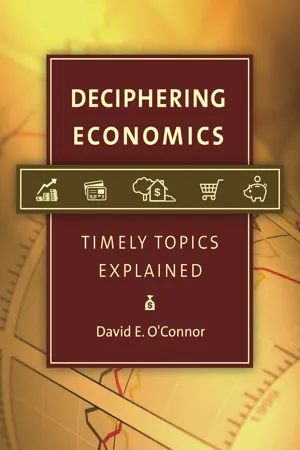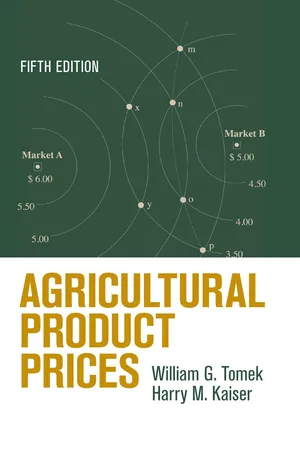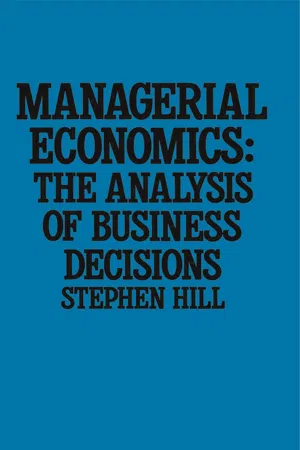Economics
Determinants of Demand
Determinants of demand are the factors that influence the quantity of a good or service that consumers are willing and able to purchase at various prices. These determinants include consumer preferences, income levels, prices of related goods, expectations about future prices, and the number of buyers in the market. Changes in these determinants can shift the entire demand curve.
Written by Perlego with AI-assistance
Related key terms
1 of 5
12 Key excerpts on "Determinants of Demand"
- eBook - ePub
- Tom Craig, David Campbell(Authors)
- 2012(Publication Date)
- Routledge(Publisher)
Effective demand thus takes into account the customer’s ability to buy, not just the desire – however intense that may be. We may say, therefore, that the total demand for product A is 10,000 units a month if the price is 45 pennies per unit. Thus all three components must be in place before the demand can be said to be effective.The Determinants of Demand
In seeking to answer the question why the demand for a product is as it is, we must explore the reasons behind consumer choices. We can intuitively appreciate that demand for goods and services varies, both according to the type of product and over time. There are five broad variables which determine the demand for any given product:- the financial ability to pay;
- changing tastes and fashions (i.e. changing preferences);
- the prices of other, related products;
- the consumer’s perceptions of what will happen in the future;
- the type of product it is.
Ability To Pay
The ability to pay for goods and services will obviously have a huge influence on demand. If consumers have a lot of spending power (or disposable income), demand for most products will rise. Conversely, if consumers are ‘hard up’, demand will tend to fall. The power of consumer spending will depend, among other things upon macroeconomic features such as:- the level of wage or income increases,
- tax rates,
- interest rates,
- employment and unemployment levels in the country.
Consumer Preferences
The second determinant of demand is the changing face of consumer preferences. If financial issues determine the consumer’s ability to buy, preferences concern the consumer’s willingness - eBook - ePub
Deciphering Economics
Timely Topics Explained
- David E. O'Connor(Author)
- 2014(Publication Date)
- Greenwood(Publisher)
How does a change in the overall demand for a good occur? To change the demand for a good, the ceteris paribus assumption is lifted, allowing other factors, called Determinants of Demand, to enter the picture. A change in one or more of the Determinants of Demand causes buyers to want more or less of a good at each and every price. There are six main Determinants of Demand: people’s tastes and preferences, income level, market size, price of substitute goods, price of complementary goods, and expectations.Suppose, for example, that a successful television commercial favorably affects people’s tastes and preferences for product X. The likely result is that buyers would purchase more of product X at each and every price. Perhaps at a price of $10, buyers would now be willing to purchase 4,000 items; at $8 they would buy 6,000 items; at $6 they would buy 8,000 items; at $4 they would buy 10,000 items; and at $2 they would buy 12,000 items. Hence, a change in tastes and preferences, a determinant of demand, causes the entire demand curve to shift to the right (a positive shift ). The new demand curve represents the new reality of the marketplace, so the original demand curve disappears. Of course, people’s tastes and preferences can also work against a product or service, as is often the case with fads or products that have become obsolete such as typewriters or horse-drawn wagons. A decline in people’s tastes and preferences causes a shift of the entire demand curve to the left to show that people are willing to buy less of the product at each and every price. In addition to tastes and preferences, the other Determinants of Demand include:Figure 2.4 Illustrating the Demand for Product X• Income level . An increase in people’s incomes causes the demand for most goods to increase; a decrease in income causes a decrease in demand for most products.• Market size . An increase in market size (a larger number of potential buyers) causes the demand for most goods to increase; a decrease in market size causes a decrease in demand for most products.• Price of a substitute good . An increase in the price of a substitute good causes an increase in the demand for the related product; a decrease in the price of a substitute good causes a decrease in the demand for the related product. (A substitute good - eBook - PDF
Economics
Made Simple
- Geoffrey Whitehead(Author)
- 2014(Publication Date)
- Made Simple(Publisher)
Section 3: The Theory of Price Determination This page intentionally left blank 7 Basic Ideas of Demand 7.1 Definition of Demand If production is undertaken in order to supply the 'wants' of mankind demand must be the most basic idea in economics. Every individual demands goods and services. When all the individual demands are put together the resulting composite demand is what the industry must supply if people are to achieve satisfaction. In defining 'demand', however, economists cannot equate 'demand' with 'want', because an industry cannot be expected to supply goods and services without payment. In attempting to discover the demand for a particular commodity we only consider demand that is backed by purchasing power. Man's wants are unlimited, but his demand for a particular item is very often limited if the price he must pay is too high. The demand for goods or services is therefore that quantity of the goods or services which purchasers will be prepared to buy at a given price, in a given period of time. Note particularly that price is crucial to any discussion about demand. It is meaningless to discuss the demand for motor vehicles unless we know what price range is being considered. The demand for family saloon cars at £7000 each will be very different from the demand for limousines at £90000 each. 7.2 The Conditions of Demand Demand is not fixed, but varies with changing conditions. The demand for silk stockings has been completely altered by the invention of nylon fibre, and the demand for bicycles in advanced nations has been greatly reduced by the development of motor vehicles. The chief factors affecting demand may be divided into those factors affecting the individual consumer or family of consumers and those factors affecting the total demand of the whole market. Factors Affecting the Demand of Households (a) The Tastes of the Household. Every family is different, and even members 82 Economics of the same family have different tastes and preferences. - eBook - ePub
- Andrew Barkley, Paul W. Barkley(Authors)
- 2016(Publication Date)
- Routledge(Publisher)
9DemandPlate 9.1 DemandSynopsis
This chapter highlights how consumers respond to changes in prices, income, and other economic variables. The demand curve is derived that shows the quantity of a good that consumers will purchase at different prices. The pervasiveness and importance of the law of demand are outlined, and the elasticity of demand is defined and explained. Demand determinants are discussed in detail, including prices, prices of related goods, income, tastes and preferences, expectations of future prices, and population. Business strategies for agribusinesses are emphasized. Demand, together with supply studied in Chapter 8 , forms the foundation of economics: markets.9.0 Introduction
Chapters 1 –7 describe and explain the behavior of individual economic units (producers). These economic actors use specific methods to locate the optimal point in their economic decisions. Producers select the profit-maximizing combinations of inputs and outputs, and consumers purchase combinations of goods to maximize their own utility or satisfaction. Consumers use similar logic when they decide what to purchase. The decision is based on maximizing satisfaction given income, relative prices, tastes, and a number of other factors. This chapter shows the explicit connection between individuals and markets by deriving market, or aggregate, demand curves. The chapter also explains the determinants of market demand, and re-introduces the concept of elasticity, or responsiveness of consumers to changes in prices and other economic conditions. Chapter 10 shows how supply and demand curves interact to determine the prices and quantities of goods.9.1 Demand
While supply curves stem from the marginal cost curves of individual producers, demand curves derive from decisions made by consumers when they decide which goods and services to buy. Demand reflects the purchases that consumers make as they strive to maximize utility, given prices and income. Demand is a technical term that describes consumer purchases, or: - eBook - ePub
- William G. Tomek, Harry M. Kaiser(Authors)
- 2014(Publication Date)
- Cornell University Press(Publisher)
ceteris paribus assumption permits one to ascertain the effect of one variable at a time.The foregoing discussion implies that the term dynamic is used in two ways in demand theory. First, it may refer to changes in demand that are associated with factors that influence the level of demand and that are likely to change with the passage of time. Second, it may refer to lags in adjustment. Quantity adjustments to changes in prices (or price adjustments to changes in quantities, depending on the model) do not take place instantaneously because of the costs of adjustment and the effects of consumers’ expectations about the future. The next two subsections elaborate on these dynamic factors.Changes in Demand
A change in demand is defined as a shift in the demand curve, as distinguished from movements along a demand curve (i.e., a change in quantity demanded due to a price change). The major factors influencing the level of demand may be grouped as follows:1. demographic factors, such as population size, its distribution by age, ethnicity, gender, etc.; 2. economic factors, such as income and its distribution, and the prices and availability of other products; 3. consumer tastes and preferences that may be influenced by education levels, life experiences, information and advertising, and the social context in which consumers live (i.e., lifestyle effects).These factors are sometimes called Determinants of Demand or demand shifters. Economic theory emphasizes prices of substitutes and complements and income as demand determinants, but for empirical analysis, one may need to consider other factors. As emphasized previously, all these factors are assumed constant for a given level of a demand function.The effects of changes in the demand determinants may be depicted in two ways, which are best demonstrated by an example. For this purpose, we assume a simple demand function in which quantity (Q) is a straight-line function of its price (P) and of consumer income (Y - eBook - PDF
- Irvin B. Tucker, Irvin Tucker(Authors)
- 2016(Publication Date)
- Cengage Learning EMEA(Publisher)
For example, at a price of $5, the total quantity demanded is 12 Blu-rays. 3-2 THE DISTINCTION BETWEEN CHANGES IN QUANTITY DEMANDED AND CHANGES IN DEMAND Price is not the only variable that determines how much of a good or service consumers will buy. Recall from Exhibit A-6 of Appendix 1 that the price and quantity variables in our model are subject to the ceteris paribus assumption. If we relax this assumption and allow other variables held constant to change, a variety of factors can influence the Demand A curve or schedule show-ing the various quantities of product consumers are willing to purchase at pos-sible prices during a spec-ified period of time, ceteris paribus. 60 PART 2 | Microeconomics Fundamentals Copyright 2017 Cengage Learning. All Rights Reserved. May not be copied, scanned, or duplicated, in whole or in part. Due to electronic rights, some third party content may be suppressed from the eBook and/or eChapter(s). Editorial review has deemed that any suppressed content does not materially affect the overall learning experience. Cengage Learning reserves the right to remove additional content at any time if subsequent rights restrictions require it. position of the demand curve. Because these factors are not the price of the good itself, these variables are called nonprice determinants , or simply, demand shifters . The major nonprice determinants include (1) the number of buyers; (2) tastes and preferences; (3) income; (4) expectations of future changes in prices, income, and availability of goods; and (5) prices of related goods. Before discussing these nonprice Determinants of Demand, we must pause to explain an important and possibly confusing distinction in terminology. We have been referring to a change in quantity demanded , which results solely from a change in the price. A change in quantity demanded is a movement between points along a stationary demand curve, ceteris paribus. - eBook - PDF
- Tucker, Irvin Tucker(Authors)
- 2016(Publication Date)
- Cengage Learning EMEA(Publisher)
The major nonprice determinants include (1) the number of buyers; (2) tastes and preferences; (3) income; (4) expectations of future changes in prices, income, and availability of goods; and (5) prices of related goods. Before discussing these nonprice Determinants of Demand, we must pause to explain an important and possibly confusing distinction in terminology. We have been referring to a change in quantity demanded , which results solely from a change in the price. A change in quantity demanded is a movement between points along a stationary demand curve, ceteris paribus. In Exhibit 3(a), at the price of $15, the quantity demanded is 20 million Blu-rays per year. This is shown as point A on the demand EXHIBIT 2 The Market Demand Curve for Blu-Rays Individual demand curves differ for consumers Fred and Mary. Assuming they are the only buyers in the market, the market demand curve, D total , is derived by summing horizontally the individual demand curves, D 1 and D 2 . 5 0 1 7 10 15 20 25 5 0 3 12 10 15 20 25 5 Price per Blu-ray (dollars) 0 2 5 10 15 20 25 Quantity of Blu-rays (per year) Quantity of Blu-rays (per year) Quantity of Blu-rays (per year) Fred’s demand curve + Mary’s demand curve = Market demand curve D 1 D 2 D total Market Demand Schedule for Blu-rays Quantity demanded per year Price per Blu-ray Fred þ Mary ¼ Total demand $25 1 0 1 20 2 1 3 15 3 3 6 10 4 5 9 5 5 7 12 Change in quantity demanded A movement between points along a stationary demand curve, ceteris paribus. CHAPTER 3 | Market Demand and Supply 61 Copyright 2017 Cengage Learning. All Rights Reserved. May not be copied, scanned, or duplicated, in whole or in part. Due to electronic rights, some third party content may be suppressed from the eBook and/or eChapter(s). Editorial review has deemed that any suppressed content does not materially affect the overall learning experience. - eBook - PDF
The Modern Economics of Housing
A Guide to Theory and Policy for Finance and Real Estate Professionals
- Randall Pozdena(Author)
- 1988(Publication Date)
- Praeger(Publisher)
2 The Determinants of Housing Demand The ultimate goal of this book is to make the reader understand the determinants of the price, quantity and quality of the housing we consume and the forces that generate new investment in housing or its demolition. This is not a trivial goal and achieving it will be easier if we can break into a few components the problem of analyzing housing markets. In this chapter our attention will be focused on the determinants of the demand for housing and in a later chapter we will examine the basic determinants of housing supply. As we shall see, when these two components are examined jointly, much of the way toward our goal will have been paved. THE CONCEPT OF DEMAND In trying to understand the concept of demand, it is helpful to imagine that the marketplace is populated by people acting in one of only two roles: consumers or producers. Consumers are those who hope to acquire and make use of goods and services. Producers perform the function of bringing these goods and services 20 THE MODERN ECONOMICS OF HOUSING Figure 1 Population and Real Income Shaded areas represent periods of recession as defined by the NBER. to market. In the housing market, it is simplest to think of households or families as the consumers and developers and builders as the producers. (Clearly, this simple dichotomy does not hold up under scrutiny, for a family member who does painting, maintenance and home improvements is also—temporarily at least—a producer. This is a wrinkle that can be ironed out later on.) Our focus in this chapter is on consumers, for it is they who desire to use housing. Their desire to use housing results in an expression of demand for housing. This demand for housing, however, is not unequivocal; the strength of a consumer's desire for housing will depend upon a variety of complex personal factors that determine the tastes of the consumer. - eBook - PDF
Managerial Economics
The Analysis of Business Decisions
- Stephen Hill(Author)
- 2016(Publication Date)
- Red Globe Press(Publisher)
The second is an examination of how the precise relationship between demand and those variables can be estimated in a manner that has operational value for decision-making. Demand theory It is not the intention of this chapter to summarise the vast body of knowledge that makes up the economic theory of consumer de-mand. Our purpose, rather, is to extract those parts of demand theory that can act as guides for commercial decision-making -a much more limited objective. The starting point for demand theory is an understanding of why consumers buy particular goods. The motivation of individual consumers is a complex psychological matter involving the develop-ment of consumer preferences and tastes, habit formation, the desire to conform to social norms, etc. For our purposes it is sufficient to note that goods are purchased for the satisfaction (or utility) they yield, and that the satisfaction from a particular good is generated by the various characteristics of that good. The principal tool used to analyse demand is the concept of a demand function, written as Da = [(X1 ... Xn) where Da is the demand for good a, f is a general (unspecified) function, and X 1 ... Xn are the variables that influence demand. Our first task is to identify the particular variables that influence demand. The problem later will be to transform this general function into a specific one, not only including the variables that influence the demand for a particular good but also measuring the extent to which demand is affected. Given the demand function , the influence of a particular variable upon demand can be measured by the partial derivative, &D &Xi If this partial derivative is positive, an increase in Xi will lead to an increase in demand, and conversely for negative partial derivatives. The demand influencing variable that dominates consumer de-mand theory is the price of the product. The simplest demand function is - eBook - PDF
Managerial Economics
Problem-Solving in a Digital World
- Nick Wilkinson(Author)
- 2022(Publication Date)
- Cambridge University Press(Publisher)
(f) Demographic factors These refer not only to the size of population but also to the structure of the population. In particular, different age groups tend to have different buying habits; not too many people over 40 play Pokémon or Fortnite. It is the 18 to 25 age group that affects the demand for higher education, and younger age groups that affect future demand, as discussed in Case Study 4.1. However, older people demand more health services and pensions. This has important implications for government policy and the taxpayer, as the proportion of older people in the population is steadily increasing in most developed countries. (g) Climatic factors Weather, rainfall, temperature and terrain are important. In Canada, for example, there is a greater demand for snow shovels, snow tyres and chains, salt for the roads and rust- proofing for cars. In the long run climate change is relevant in causing changes in demand; for example, an increased danger of flooding may affect the demand for housing in certain areas, and the demand for insurance. (h) Seasonal factors These refer to any regular, repeated pattern in demand. Many products have a demand that varies according to season of the year, such as air travel, hotels, car rental, jewellery and 4.3 Factors Determining Demand 167 restaurants. The latter also has a monthly pattern (more people eat out at the beginning of the month, when they have more cash), a weekly pattern (more people eat out at weekends) and a daily pattern. Many products have a daily pattern in demand, such as public transport, electricity, telephone calls and health clubs. This also has implications for pricing; many firms use peak and off-peak pricing. This will be examined in more detail in Chapter 12. (i) Macroeconomic factors These include income, discussed earlier, and also interest rates, exchange rates, inflation rates and unemployment rates. If interest rates fall, for example, this may affect demand, for two reasons. - Peter Davis, Eliana Garcés, Eliana Garces-Tolon(Authors)
- 2009(Publication Date)
- Princeton University Press(Publisher)
1
The Determinants of Market Outcomes
A solid knowledge of both econometric and economic theory is crucial when designing and implementing empirical work in economics. Econometric theory provides a framework for evaluating whether data can distinguish between hypotheses of interest. Economic theory provides guidance and discipline in empirical investigations. In this chapter, we first review the basic principles underlying the analysis of demand, supply, and pricing functions, as well as the concept and application of Nash equilibrium. We then review elementary oligopoly theory, which is the foundation of many of the empirical strategies discussed in this book. Continuing to develop the foundations for high-quality empirical work, in chapter 2 we review the important elements of econometrics for investigations. Following these first two review chapters, chapters 3 –10 develop the core of the material in the book. The concepts reviewed in these first two introductory chapters will be familiar to all competition economists, but it is worthwhile reviewing them since understanding these key elements of economic analysis is crucial for an appropriate use of quantitative techniques.1.1 Demand Functions and Demand Elasticities
The analysis of demand is probably the single most important component of most empirical exercises in antitrust investigations. It is impossible to quantify the likelihood or the effect of a change in firm behavior if we do not have information about the potential response of its customers. Although every economist is familiar with the shape and meaning of the demand function, we will take the time to briefly review the derivation of the demand and its main properties since basic conceptual errors in its handling are not uncommon in practice. In subsequent chapters we will see that demand functions are critical for many results in empirical work undertaken in the competition arena.- eBook - PDF
Recreational Tourism
Demands and Impacts
- Chris Ryan(Author)
- 2003(Publication Date)
- Channel View Publications(Publisher)
(7) rates of exchange; (8) cost of travel; (9) exogenous factors like an oil crisis, pilots’ strike, foot and mouth disease or terrorist action. Of course, such an approach says little if anything about the perceived attractiveness of the destination, and it leaves unstated the supply side of the equation other than through the indirect pressures on their costs that destinations may experience. There is some evidence that the market struc-tures have more influence than might otherwise be thought. For example, in a study of Mallorca, Aguiló, Alegre and Riera (2001) argued that, in the case of German package holidays, the hotel category, type of board and location were significant explanatory determinants of price. They went on to comment that ‘…the inclusion of the identity of the tour operators as an explanatory variable is also statistically significant’ (Aguiló et al ., 2001: 72). To some extent they were confirming the earlier and similar findings of Sinclair, Clewer and Pack (1990) in their study of Malaga. However, a demand-side economist would object that the success of any operation is still determined by the acceptability of the price to sufficient market segments that are large enough to generate the required volume necessary for profitability. In short, demand is the important component. A Review of Evidence This contention raises the question, what is the evidence? It has been shown that a series of potentially testable economic relationships can be hypothesised, and indeed the literature contains many examples of attempts to explain tourist flows by the use of econometric modelling. While there is a consensus that income, exchange rates and travel costs are important, there is a lack of consensus about the contribution that each makes to determining demand, and under what conditions one might be more important than the other.
Index pages curate the most relevant extracts from our library of academic textbooks. They’ve been created using an in-house natural language model (NLM), each adding context and meaning to key research topics.











